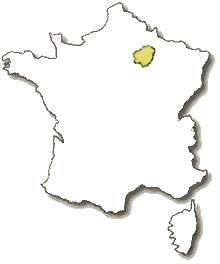Throughout the world and history there
are hundreds of different wine regions around the world. In the old world,
there are even multiple wine regions within each country of Europe. France
alone has approximately 14 major wine regions. Within these major regions, the
region Champagne has become an extremely well known wine region, even for the
non wine drinkers.
Located in the north eastern part of
France, the Champagne region covers a pretty large area of land. The location
can be seen in the map of France below, as well as a more zoomed out map of
Europe.
It is obvious that the Champagne region
is very large, and therefore is broken down in several sub-regions. These four
major sub-regions consist of The Mountain of Reims, The Marne Valley, The Cote
des Blancs, and The Cotes des Bars and Montgueux. These regions can be seen in this zoomed in
map of just the Champagne region itself below.
Geographically, Champagne is actually relatively pretty close to the
city of Paris; just 90 minutes northeast of the city.
Historically, Champagne has been an
official wine region since 1927, when the first appellation of Champagne was
created. However, this region has a history of growing wine since the third
century A.D. This region has been
comprised of approximately 43,680 acres of vineyards. Today , there are over 20,000 growers
throughout the region. Champagne in the United States has become the famous
sparkling wine that everyone makes a toast to and drinks on New Year’s Eve.
However, the bubbles and sparkling aspect of the wine was not originally
intentional. It was only discovered when the popping of the bottle opening
occurred, and a process of making Champagne because intentional to create the
bubbles. Today, the correct amount of CO2, fruit, and acidity are what makes
Champagne a good Champagne.
Champagne historically became an
official region in 1927 when the Champagne Appellation of Controlled Origin
(AOC) came about. This government-sponsored control agency protects the
reputation of Champagne only allowing wines that come from the specified region,
maintaining the high standard of quality and fermentation process, to be called
Champagne. This basically protects the historical name of Champagne, and keeps
anyone from outside the region to replicate it. In addition, the Comite
Interprofessionnel du Vin de Champagne (CIVC) helps regulate the production of
Champagne as well as distribution, promotion, and research of Champange. Below
are two pictures of different Champagne labels, that must meet all of these government
agency requirements in order for Champagne to be used on the label.
There are three main grape varieties
that contribute to Champagne. These include Pinot Nior, Pinot Meunier, and
Chardonnay. With these wine varieties, there are three major different types of
Champagne as well. The first is non vintage/multiple vintage Champagne wine that
consists of a blend of two or more harvests. Second is a Vintage Champagne that
comes solely from a single vintage. Lastly is
“Prestige” cuvee, which consists of only one vintage, however it has
longer aging requirements. This type
usually is more highly rated out of all three Champagne types. This is because “Prestige”
cuvee Champagnes are made from the best and first pressing of the grapes, aged
longer in the bottle, and made solely from vintage years. Lastly there is not
as much of this type of wine produce, therefore it creates a higher demand for
this wine.
Lastly, in order to even be able to
create these different types of Champagne, there is a reason of wine Champagne
is the way it is and that the region is located where it is as well. Climate
and soil play a huge role in the creation of Champagne. First of all, the
Champagne region is relatively north from the equator compared to other wine
regions throughout the world. Because of the slightly northern climate, the grapes
picked for Champagne usually have a higher acidity than other grapes. The soil
here is known to be chalky. This soil mixed with a climate of random sunshine,
harsh climate, and shorter growing season, is what makes Champagne the way it
is. The four different sub regions mentioned early also all bring slightly
different soil characteristics and climate to the Champagne region as well.
This is slightly because of the Marne River that runs through the middle of the
region. Below are examples of two different pictures of vineyards throughout
the Champagne region.
Lastly Champagne has very unique
characteristics that make the wine from this region stand out compared to the
others. For example, probably the most obvious is that it is a sparkling wine that
requires a specific bottle cork. It is
famous for popping the cork and letting the bubbles explode out of the bottle.
However there are methods of opening the bottle in order to avoid this.
Champagne also has a specific type of glass wear including the flute and the
tulip shaped glass, in order to keep the bubbles in the glass longer.
WORKS CITED
"Champagne Map Wine
Region." Champagne Map Wine Region. N.p., n.d. Web. 23 Apr. 2013. <http://www.terroir-france.com/wine/champagne_map.htm>.
"Champagne Region « Wine
Origins." Champagne Region « Wine Origins. N.p., n.d. Web. 23 Apr.
2013. <http://www.wineorigins.com/?page_id=44>.
Zraly, Kevin. Kevin Zraly's
Windows on the World Complete Wine Course. New York: Sterling, 2012. Print.






No comments:
Post a Comment